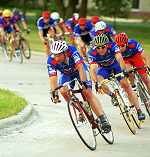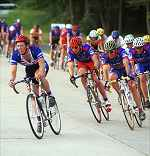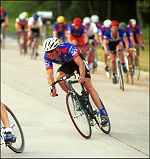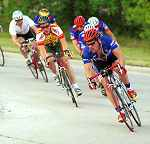

If you haven’t already guessed from this shameless allusion to the popular film, Mr. Stanifer was my high school band director. Stanifer was a visionary hired by a group of visionaries. Bedford Township, back in nineteen ya-dee-dee-ya, was just beginning to grow. When we first matched muscle and music with Toledo suburban schools on fall Friday nights, our mascot, the kicking mule, seemed an appropriate joke. So a group of parents called themselves the Athletic Boosters and pressed the school board to get serious about football, and another group of parents called themselves the Band Boosters and pressed the school board to get serious about the music program.
It was Mr. Stanifer’s job to turn this bunch of kids (count me as one) who played a cacophony as they walked across the football field in loose formation, sometimes to the left, sometimes to the right, sometimes even diagonally, into a real Marching Band. He got the Band Boosters to spend thousands on a video system (this was before Beta) so that he could tape our rehearsals, play them back to us, and critique every step. He would also play for us tapes of Ohio State/Michigan halftime shows, so we could see what a real marching band sounded and looked like. And, like most good teachers do, he made analogies out of things from our everyday lives.
The analogy I remember best is the one where Mr. Stanifer is stuck during rush hour at Wernert’s Corner, a busy five-way intersection in West Toledo. He notices that only five or six cars get through on each cycle. After careful examination, he sees that there is, after each light turns green, a delayed reaction between the acceleration of each car in line. Sometimes a driver is not paying attention, which holds up the flow further. "What if everyone," Mr. Stanifer asked the band, "hit the gas at the same time the moment the light turned green? Imagine how many would get through." This, of course, got our attention. Then Mr. Stanifer took all of the grumbling about why it wouldn’t work at Wernert’s Corner and showed us how a marching band in formation is not limited by the realities of a traffic light.
This traffic-light analogy comes back to me every now and then, as it did so last Friday at the Perrysburg Grand Prix. Anyone watching the Citizen/5's, the 3/4's, and the 1/2's, noticed varying degrees of Stanifer’s traffic-light effect upon the racers’ entering and exiting those very tight corners. Not surprisingly, the Citizen/5's were all spread out, the 3/4's were much tighter, and the 1/2's flew through in pretty much the same formation they maintained in the straightaways.
 It is much the same at our club criteriums. If you’re at the front or off the front in a small break, the traffic-light effect is small; if you’re at or near the back of the peloton, the traffic-light effect is sometimes quite large. The problem with the traffic-light effect, a. k. a., the accordion effect, in a crit is efficiency. The pack tightens back up after each corner, and it’s a lot of extra work sprinting out of every corner for everybody near the back. The old adage, you want to be near the front, is a fine one, but as 40-plus starters becomes the norm on Thursday night, maintaining prime position becomes increasingly difficult.
It is much the same at our club criteriums. If you’re at the front or off the front in a small break, the traffic-light effect is small; if you’re at or near the back of the peloton, the traffic-light effect is sometimes quite large. The problem with the traffic-light effect, a. k. a., the accordion effect, in a crit is efficiency. The pack tightens back up after each corner, and it’s a lot of extra work sprinting out of every corner for everybody near the back. The old adage, you want to be near the front, is a fine one, but as 40-plus starters becomes the norm on Thursday night, maintaining prime position becomes increasingly difficult.Most long-time observers of the club agree that the speed and competitiveness of our races has increased over the years. The numbers are up. The quality of skills throughout the peloton, though not bad, leaves room for improvement. Whether you’re rounding one of the four corners at WestWinds Business Center or the only one at WoodBridge Industrial Park, you can choose to pedal or not pedal. However, since at various points in the race the peloton will use both methods, you should be technically sound both pedaling around a corner and not. If the riders in front of you pedal, you’ll get gapped if you don’t pedal too.

Given a smooth, dry surface, speed is the factor that determines whether one can pedal through a corner. The higher the speed, the more one must lean; after a certain angle, the inside pedal scrapes the ground. How far is that? One can measure the angle, to be sure, but what good is that measurement out there in a race? You’ll probably have to find it through trial and error. Touching one’s pedal, though quite a rush, rarely ever leads to a crash. Seeing sparks fly from a pedal up the road, sometimes a bigger rush, can also help judge where in the speed/lean equation you should leave your pedal up. Show me a crit racer who hasn’t ground a few grams off of the bottom of his or her pedals, and you haven’t shown me a crit racer.
You can increase pedal clearance if you hold the bike upright through the corner. Do so by aligning your nose with or slightly outside the right brake hood. (I’m speaking here of right-hand turns. Ouch, the Perrysburg Grand Prix threw left-handers at them too.) As with any skill, you need to practice this until it becomes automatic. It’s probably a good idea to set up this way for all pedal-through corners regardless of the speed.
When it’s down to the last lap at WestWinds, or most any moderately fast lap at WoodBridge, you’ll likely be forced to not pedal. Here the setup is the opposite: line your nose up with the left brake hood and put as much of your weight as you feel comfortable doing so on your left pedal. By assuming this position and weighting the left (the outside pedal or the one that’s down) pedal you lower your center of gravity. Weighting the outside pedal is very important. You can really carve through a tight corner at speed. I don’t claim to understand the physics of why this is so; I just know that it works.
Another factor that adds to the traffic-light effect is confidence. Everyone needs to have confidence in his or her cornering
 skills and confidence in everyone else’s, which isn’t going to happen overnight or by reading ten thousand pages on bike handling. Mr. Stanifer was trying to convince me that I would not bowl over the horn player in front of me with my bass drum if I took that first step with all of the pomp and precision of Ohio State’s senior first tuba (you know, the guy who struts out across the field and dots the i in Ohio), but his overall vision was perfect precision from his eighty-piece marching band. Perfection in the peloton would be a lofty goal. Especially when some of the more skilled riders occasionally use the traffic-light effect to their advantage. They sit on the back, start coasting before the corner and thereby leave a small gap. Then, by not touching their brakes, they go through the corner faster than those in front, thereby closing that gap back up without turning a pedal. Some call it "shooting" a corner or riding "tail-gunner."
skills and confidence in everyone else’s, which isn’t going to happen overnight or by reading ten thousand pages on bike handling. Mr. Stanifer was trying to convince me that I would not bowl over the horn player in front of me with my bass drum if I took that first step with all of the pomp and precision of Ohio State’s senior first tuba (you know, the guy who struts out across the field and dots the i in Ohio), but his overall vision was perfect precision from his eighty-piece marching band. Perfection in the peloton would be a lofty goal. Especially when some of the more skilled riders occasionally use the traffic-light effect to their advantage. They sit on the back, start coasting before the corner and thereby leave a small gap. Then, by not touching their brakes, they go through the corner faster than those in front, thereby closing that gap back up without turning a pedal. Some call it "shooting" a corner or riding "tail-gunner."I mentioned the B-word, brakes. I know that you’ve heard the imperative, don’t touch your brakes in the corners. It is, however, quite easy to find yourself between a rock and a hard place when it gets bunched up in a corner. The best way to
 avoid these situations, and a general rule of riding in any peloton, is to look up the road at the flow up front and anticipate how that will filter back to you. If you see things strung out up there, you’re likely coming up on a fast corner; if it’s all bunched up, the corner is likely to be easy. In either case, upon entering the corner, you can back off slightly from the normal distance you leave between yourself and the rider in front of you. (We’re not marching on a football field; no one’s going to care whether you set up on the 45-yardline or the 44 and 1/2. Just don’t make it the 43.) If braking is required to maintain that distance, do it before you enter the corner. When it is absolutely necessary to brake in the corner, feather your front brake first. Hopefully that’s all it will take. If you have to apply more than a feather touch to the front brake, squeeze it a little more while adding gentle pressure to the rear brake.
avoid these situations, and a general rule of riding in any peloton, is to look up the road at the flow up front and anticipate how that will filter back to you. If you see things strung out up there, you’re likely coming up on a fast corner; if it’s all bunched up, the corner is likely to be easy. In either case, upon entering the corner, you can back off slightly from the normal distance you leave between yourself and the rider in front of you. (We’re not marching on a football field; no one’s going to care whether you set up on the 45-yardline or the 44 and 1/2. Just don’t make it the 43.) If braking is required to maintain that distance, do it before you enter the corner. When it is absolutely necessary to brake in the corner, feather your front brake first. Hopefully that’s all it will take. If you have to apply more than a feather touch to the front brake, squeeze it a little more while adding gentle pressure to the rear brake.Mr. Stanifer never got his perfect performance, not in my career, but the band did get markedly better, one player at a time. It’s likely that our peloton will improve its cornering one rider at a time as well. The skilled riders will continue to congregate at the front, but with more skilled riders there the number of riders cornering like the 1/2's at the Perrysburg Grand Prix gets larger. That would increase the efficiency of the peloton and the racing could potentially get even faster and more competitive. As for the tail-gunners, the beat goes on.
